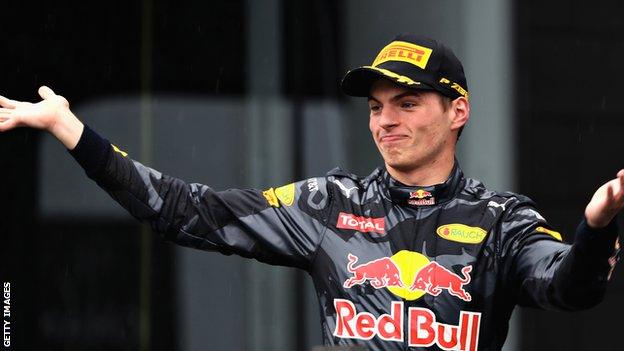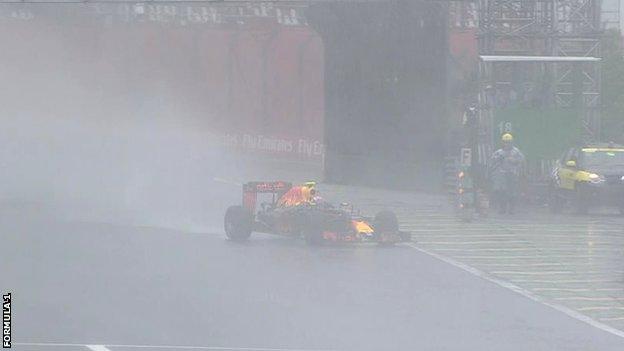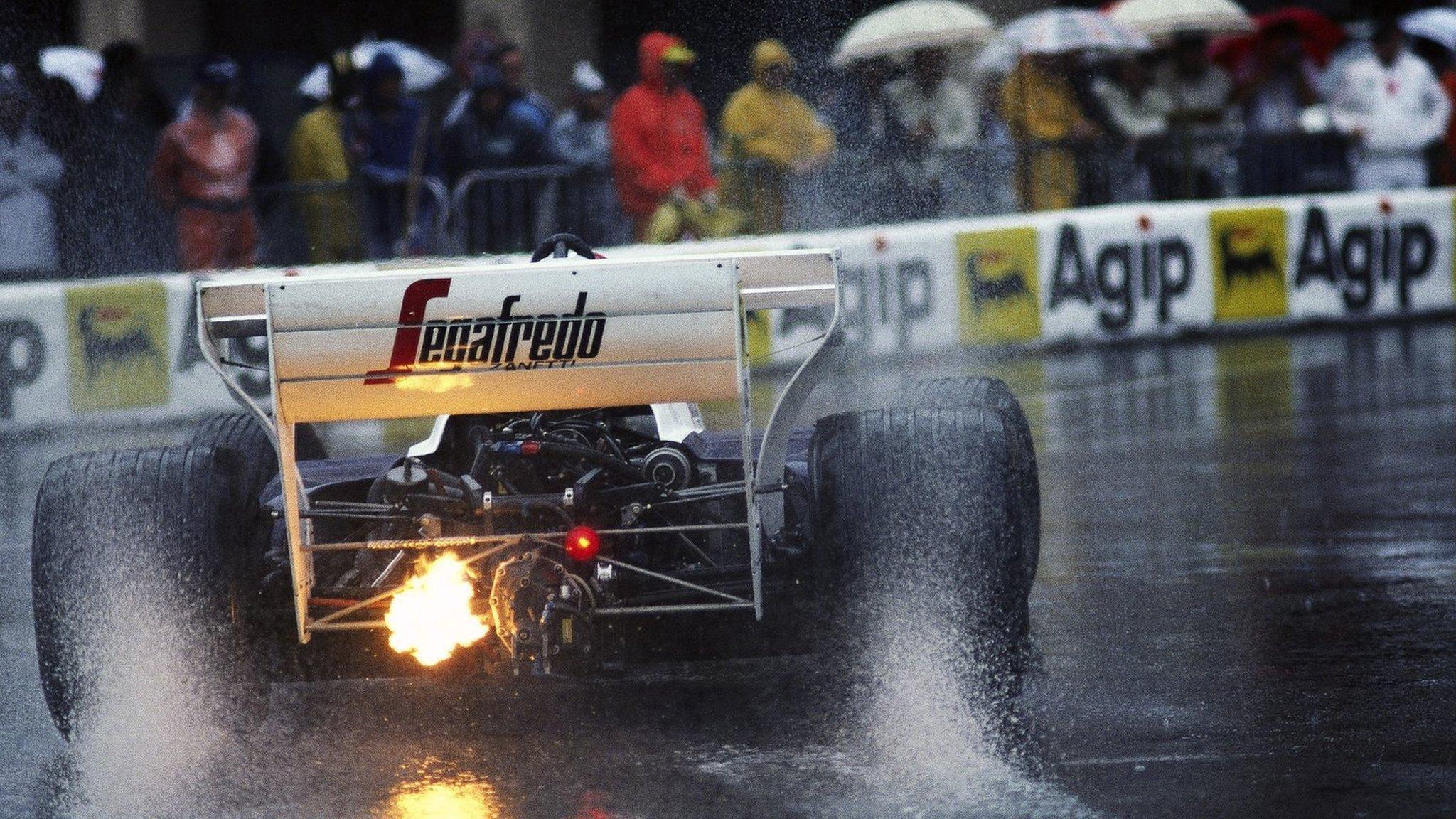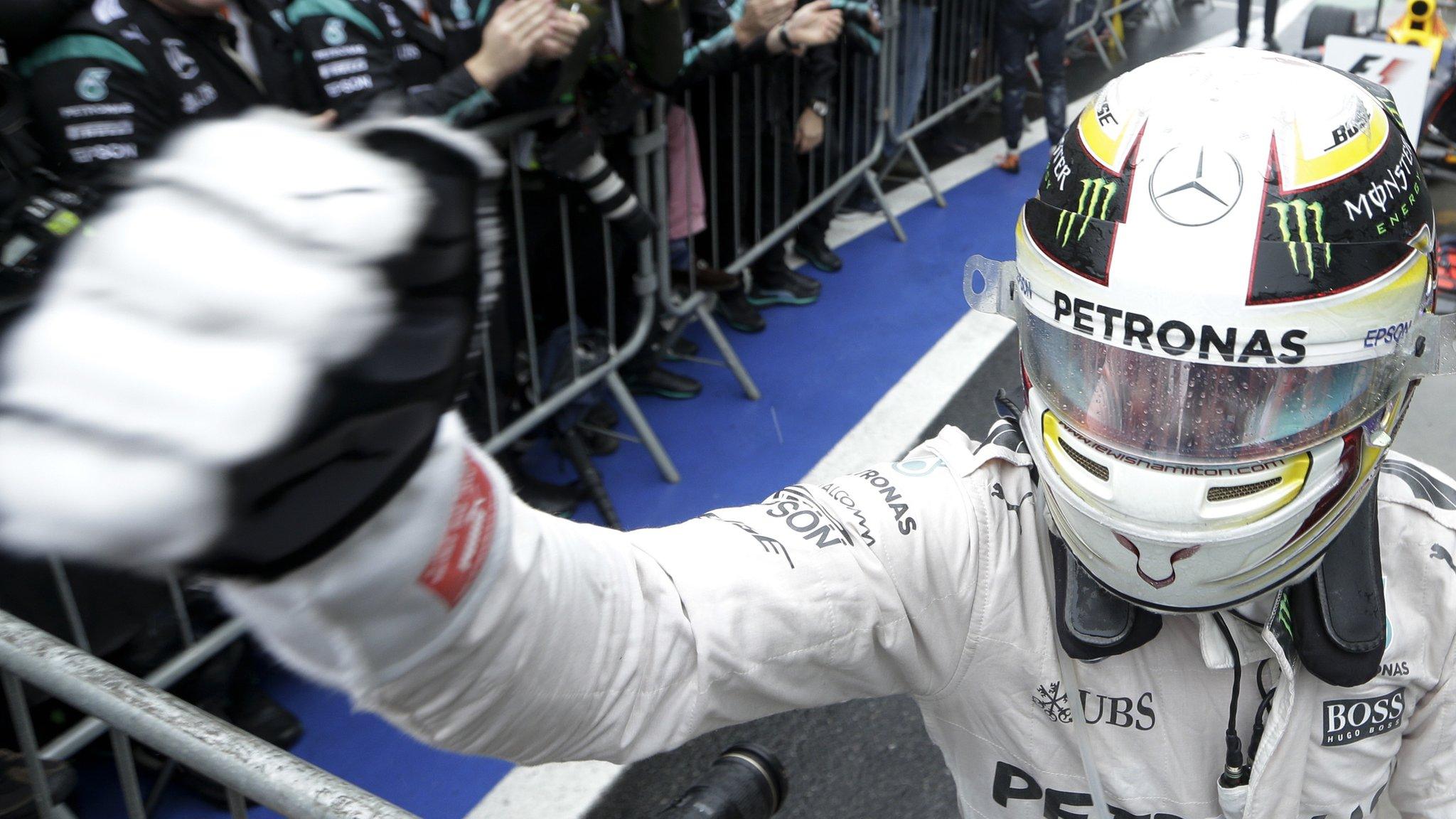Max Verstappen's drive in Brazil puts him in the company of the legends - Allan McNish
- Published

Verstappen dropped to 16th after a pit stop with 16 laps to go but fought back to finish on the podium in treacherous conditions
About every 10 years or so, there is a race in which one driver makes his mark and produces a performance that will be remembered for decades to come.
Max Verstappen at Sunday's Brazilian Grand Prix was one of those days.
It happened with Ayrton Senna at Monaco in 1984, when he was so close to beating Alain Prost's McLaren in a Toleman at Monaco in his first Formula 1 season.
It happened with Michael Schumacher in Barcelona in 1996, when in torrential rain he regularly lapped five seconds quicker than anyone else and won by 45 seconds.
And it happened with Lewis Hamilton at Silverstone in 2008, with a remarkably similar performance to Schumacher's in dreadful conditions, winning by more than a minute.

Ayrton Senna at Monaco in 1984 - Verstappen's drive puts him in exalted company
Verstappen did not win, but the 19-year-old Dutchman's drive at Interlagos was right up there with those and other legendary performances in F1 history.
The final proof
The race was the final piece of evidence that was needed to prove Verstappen really has the potential to be something very special indeed.
He has been impressive since he started his career last season but, until quite recently, Australian team-mate Daniel Ricciardo had had the edge this year at Red Bull.
That has turned around in the last three races or so, and now Brazil has sealed the deal.
The three drivers mentioned at the start of this piece have 14 world titles between them. Verstappen, it is clear, is up with them in terms of capability.
Whether he transfers that into world titles, time will tell. But to do what he did in Brazil showed he has all the assets he needs to get the job done.
Verstappen already has that aura about him. People like watching him because he's spectacular. Even before the race started, there was a sense he would have a go and make something happen.
And when he came back out on the wet tyre after Red Bull abandoned their mistaken plan to try the intermediates, it was not a question of whether he would get in the points but whether he would get on the podium.
Only the real superstars have that about them.
The challenges of the wet
The wet takes away a lot of parameters that define performance, and the driver has a bigger influence on the speed of the car.
There's the basic skill required, of course. You need a heightened sensitivity and feel.
Reactions have to be super-quick, as was clear not only with the number of spins and near-spins, but also scary moments such as Manor's Esteban Ocon only just avoiding colliding with Kimi Raikkonen's stationary Ferrari on the pit straight at 200mph.
Spacial awareness becomes a critical factor. With the spray, a driver cannot see in front of him, so he has to have good peripheral vision to see where he is on track, such as looking for brake marker boards to know when to get off the throttle. The best way to describe it is as follows: think of driving down the motorway in torrential rain with a car in front of you throwing up spray and you have no windscreen wipers.
You need real focus, too, because driving flat out in heavy rain is so much more mentally tiring than you can imagine. You just never relax.
And then there's the one thing that really stood out with Verstappen - massive confidence, in yourself and the car.
The limits are changing every single corner, every single lap. The track evolves with the amount of rain, whether it is getting wetter or drier. At 200mph you are travelling at 90 metres per second. So if you brake too late by 0.1secs, you have travelled nine metres, and the track width is generally a bit less than that.
The margin for error is so much less in the wet than in the dry, because you have less grip, both in braking and, particularly, cornering.
That means you need to have real feel to go through the transition between longitudinal and lateral grip as you ease off the brakes and turn into the corner.
Why was it so good? Part one - that save

"Well held, Max," came the message from Red Bull after his stunning save at 190mph on the start-finish straight. "Heartbeat went a bit higher there," came the cool reply
There were a number of highly impressive aspects of Verstappen's drive and the first was apparent in a moment when it nearly came to an end - his half-spin on the pit straight.
It happened because the car aquaplaned, or floated on top of standing water - as did those of many others through the race. But the reason why it happened was different in Verstappen's case.
Most aquaplaned because they got on to the white line on the inside of the track as they accelerated up the first part of the curved pit straight out of the last corner. And they went on that because they were trying to keep the loaded right-rear tyre off the rivers on the outside of the track.
At one point, they could not avoid the rivers, so the right rear lost grip and around the car went - as with Sebastian Vettel and Fernando Alonso, among others.
Verstappen, though, was using a completely different line in various places, including Juncao, the last corner.
He went really wide, always on to that wetter outside part of the circuit. By doing that, he had a straighter exit out of the final corner, so he had better acceleration. He had less steering and a more constant steering input through the long, uphill left-hander, which in theory gave less risk of spinning.
But the negative was that he was in that deeper water much more often than the other guys and in the end it caught him out once and it flicked the car sideways.
In recovering that moment, two things were highly impressive.
First, Verstappen got the opposite steering lock on extremely quickly and came off the throttle. His reactions were instantaneous.
But then he straightened the wheel, and that meant he could have a four-wheel slide as opposed to the car looping around doing 360s. Because once you start doing 360s, you are basically sitting there waiting to hit something.
He could then release the brake so the car was agile again, and go on his way. It was not just about fast reactions, but also the whole computation of what to do next to keep the car in some semblance of control. That was the key to him not hitting the wall, as Felipe Massa and Marcus Ericsson did there.
The second thing that was super-impressive was that once he knocked it down a gear and got going, Verstappen had Nico Rosberg's Mercedes on his outside. Yet going into Turn One he was as committed as ever and held on to the place. The fact that he had nearly binned the car at 170mph a few seconds before was instantly forgotten.
Part two - stunning passing moves

Verstappen passes Sebastian Vettel for fifth place late on - "a really sweet move"
The racing lines Verstappen was using were not as radical as some have suggested. They were quite logical - he was searching for grip. A standard dry racing line generally has less grip in the wet because of all the rubber and oil that is ingrained in the asphalt.
In addition to exploring different lines, he used an attacking driving style. This generated tyre temperature, whereas other drivers who were more tentative and sensitive with the car were not able to do that and it is then a downward spiral.
This looks like what happened to Jenson Button on Sunday to make him so much slower than team-mate Alonso, for example. And to Nico Rosberg in Monaco to make him so slow in comparison to Lewis Hamilton.
Confidence led to attacking, which led to tyre temperature, which led to grip. That allowed him to run around the outside and go to places on the circuits others felt they couldn't.
Verstappen made a number of highly skilled overtaking manoeuvres.
The one I liked most was when he passed Sebastian Vettel's Ferrari during his climb back up from 14th to third in the last 15 laps.
He thought about trying around the outside of Turn Four, but decided to pull back. Then I suspected he would go around the outside of Turn 11, where he had passed team-mate Ricciardo a few laps before - another very good move. But he did not get a good enough exit out of the previous hairpin, so was not close enough.
Instead, he switched sides and dived down the inside into the last corner, and perhaps because of Turn Four, he made sure Vettel knew he was there and ran him out wide. It was a really sweet move - and it showed maturity not to rush it early in the lap.
The others who stood out
Verstappen was not the only driver to impress in Brazil.
Carlos Sainz did another great job in getting the Toro Rosso up to fourth and finally finishing sixth.
He probably benefited from the fact that car has good downforce and with less power from his 2015 engine, which maybe helped for once in being a little more drivable. But he still needed to do the job, and when he got the chance to deliver, he did, mixing it with cars that are much faster.
Sergio Perez was excellent for Force India - so close to another podium. When you think back to where he was when he was dropped by McLaren at the end of 2013, it's like two different drivers.
In an odd way, Rosberg impressed me too. He was measured and balanced and did what he needed to do to protect his championship advantage.
That should not be underestimated - in his position it is so much easier to make a mistake than to get it right in those conditions. And he very nearly did with that snap of oversteer on the pit straight, which he rescued very well.
Felipe Nasr put in a neat little drive too, to finally grab some incredibly valuable points for Sauber.
And of course Hamilton. He was faultless. He said it was easy. I don't believe that. I think that was for the cameras, and a bit of mind games with Rosberg.
But he was the only driver we did not see make a mistake of any kind. He controlled it from the beginning and pulled away from everyone else in the most difficult conditions we have seen for a very long time.
That was a very good drive and reminiscent of Alain Prost at his best - appropriately so, as Hamilton took his 52nd grand prix victory without apparent fuss or drama, and in doing so overtook the Frenchman in the all-time wins statistics.
Allan McNish was talking to BBC Sport's Andrew Benson
- Published30 June 2017
- Published14 November 2016
- Published14 November 2016

- Published13 November 2016
